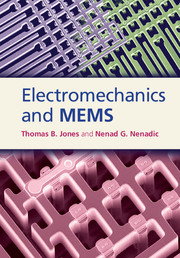Book contents
- Frontmatter
- Contents
- Preface
- 1 Introduction
- 2 Circuit-based modeling
- 3 Capacitive lumped parameter electromechanics
- 4 Small-signal capacitive electromechanical systems
- 5 Capacitive sensing and resonant drive circuits
- 6 Distributed 1-D and 2-D capacitive electromechanical structures
- 7 Practical MEMS devices
- 8 Electromechanics of piezoelectric elements
- 9 Electromechanics of magnetic MEMS devices
- Appendix A Review of quasistatic electromagnetics
- Appendix B Review of mechanical resonators
- Appendix C Micromachining
- Appendix D A brief review of solid mechanics
- Index
- References
6 - Distributed 1-D and 2-D capacitive electromechanical structures
Published online by Cambridge University Press: 05 May 2013
- Frontmatter
- Contents
- Preface
- 1 Introduction
- 2 Circuit-based modeling
- 3 Capacitive lumped parameter electromechanics
- 4 Small-signal capacitive electromechanical systems
- 5 Capacitive sensing and resonant drive circuits
- 6 Distributed 1-D and 2-D capacitive electromechanical structures
- 7 Practical MEMS devices
- 8 Electromechanics of piezoelectric elements
- 9 Electromechanics of magnetic MEMS devices
- Appendix A Review of quasistatic electromagnetics
- Appendix B Review of mechanical resonators
- Appendix C Micromachining
- Appendix D A brief review of solid mechanics
- Index
- References
Summary
Introduction
Previous chapters of this text have relied exclusively on lumped parameter capacitance models with mechanical motion represented by one or perhaps a few discrete mechanical variables. In these models, the capacitive electrodes have been assumed to be rigid structures. In MEMS, however, many of the common designs do not fit such a description. For example, one of the most widely exploited structures is the cantilevered beam, a 1-D continuum. Also, pressure sensors and microphonic transducers are usually based on deformable 2-D continua, typically circular diaphragms. Other applications of MEMS continua exist and are growing in numbers. For example, Fig. 6.1 shows a deformable mirror, developed by Boston Micromachines Corporation, for use in laser-pulse-shaping applications where the deformable mirror modifies the phase of the spectral components of the laser pulse to achieve desired temporal pulse characteristics.
This chapter develops modeling approaches for such continua and demonstrates that it is usually possible to devise reduced-order, lumped-parameter models that capture the essential behavior and reveal important trade-offs amongst the system parameters. Section 6.2 employs this approach, using the simple example of a cantilevered beam operated as a capacitive transducer. After introducing some basics from the mechanics of continua, a familiar-looking lumped parameter model is extracted and then tested for accuracy by comparing the predicted resonant frequency with the well-known analytical solution for the cantilevered beam. In the initial exercise, certain assumptions and approximations are presented without much explanation but these are tested and justified in Section 6.3 in a detailed revisit to the problem. The effort leads naturally to the electromechanical two-port transducer representations of Chapter 4. In subsequent sections, the same treatment is extended to the important geometry of the circular diaphragm.
- Type
- Chapter
- Information
- Electromechanics and MEMS , pp. 223 - 297Publisher: Cambridge University PressPrint publication year: 2013



